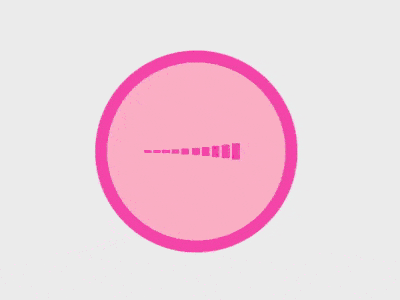 Web Front-end
Web Front-end
 CSS Tutorial
CSS Tutorial
 How to use pure CSS to implement a pulsating loader (source code attached)
How to use pure CSS to implement a pulsating loader (source code attached)
How to use pure CSS to implement a pulsating loader (source code attached)
The content of this article is about how to use pure CSS to implement a pulsating loader (source code attached). It has certain reference value. Friends in need can refer to it. I hope it will be helpful to you. help.
Effect preview

Source code download
https://github.com/comehope/front-end-daily -challenges
Code interpretation
Define dom, the container contains 10 sub-elements:
<div> <span></span> <span></span> <span></span> <span></span> <span></span> <span></span> <span></span> <span></span> <span></span> <span></span> </div>
Centered display:
body {
margin: 0;
height: 100vh;
display: flex;
align-items: center;
justify-content: center;
background: linear-gradient(#eee 70%, pink);
}Set the style of the container, which is pink A circle with background and stroke:
.loader {
width: 6em;
height: 6em;
padding: 3em;
font-size: 10px;
background-color: pink;
border-radius: 50%;
border: 0.8em solid hotpink;
}Set the layout mode of the sub-element to horizontal tile:
.loader {
display: flex;
align-items: center;
justify-content: space-between;
}Set the style of the sub-element:
.loader > span {
width: 0.5em;
height: 50%;
background-color: deeppink;
}Add the sub-element’s Animation effect:
.loader > span {
transform: scaleY(0.05) translateX(-0.5em);
animation: span-animate 1.5s infinite ease-in-out;
}
@keyframes span-animate {
0%, 100% {
transform: scaleY(0.05) translateX(-0.5em);
}
15% {
transform: scaleY(1.2) translateX(1em);
}
90%, 100% {
background-color: hotpink;
}
}Set the subscript of the sub-element and let the sub-elements play animation in sequence:
.loader > span {
animation-delay: calc(var(--n) * 0.05s);
}
.loader > span:nth-child(1) { --n: 1; }
.loader > span:nth-child(2) { --n: 2; }
.loader > span:nth-child(3) { --n: 3; }
.loader > span:nth-child(4) { --n: 4; }
.loader > span:nth-child(5) { --n: 5; }
.loader > span:nth-child(6) { --n: 6; }
.loader > span:nth-child(7) { --n: 7; }
.loader > span:nth-child(8) { --n: 8; }
.loader > span:nth-child(9) { --n: 9; }
.loader > span:nth-child(10) { --n: 10; }Add container animation to enhance the pulsating effect:
.loader {
animation: loader-animate 1.5s infinite ease-in-out;
}
@keyframes loader-animate {
45%, 55% {
transform: scale(1.05);
}
}You’re done!
The above is the detailed content of How to use pure CSS to implement a pulsating loader (source code attached). For more information, please follow other related articles on the PHP Chinese website!

Hot AI Tools

Undresser.AI Undress
AI-powered app for creating realistic nude photos

AI Clothes Remover
Online AI tool for removing clothes from photos.

Undress AI Tool
Undress images for free

Clothoff.io
AI clothes remover

Video Face Swap
Swap faces in any video effortlessly with our completely free AI face swap tool!

Hot Article

Hot Tools

Notepad++7.3.1
Easy-to-use and free code editor

SublimeText3 Chinese version
Chinese version, very easy to use

Zend Studio 13.0.1
Powerful PHP integrated development environment

Dreamweaver CS6
Visual web development tools

SublimeText3 Mac version
God-level code editing software (SublimeText3)

Hot Topics
 How to use bootstrap in vue
Apr 07, 2025 pm 11:33 PM
How to use bootstrap in vue
Apr 07, 2025 pm 11:33 PM
Using Bootstrap in Vue.js is divided into five steps: Install Bootstrap. Import Bootstrap in main.js. Use the Bootstrap component directly in the template. Optional: Custom style. Optional: Use plug-ins.
 The Roles of HTML, CSS, and JavaScript: Core Responsibilities
Apr 08, 2025 pm 07:05 PM
The Roles of HTML, CSS, and JavaScript: Core Responsibilities
Apr 08, 2025 pm 07:05 PM
HTML defines the web structure, CSS is responsible for style and layout, and JavaScript gives dynamic interaction. The three perform their duties in web development and jointly build a colorful website.
 React's Role in HTML: Enhancing User Experience
Apr 09, 2025 am 12:11 AM
React's Role in HTML: Enhancing User Experience
Apr 09, 2025 am 12:11 AM
React combines JSX and HTML to improve user experience. 1) JSX embeds HTML to make development more intuitive. 2) The virtual DOM mechanism optimizes performance and reduces DOM operations. 3) Component-based management UI to improve maintainability. 4) State management and event processing enhance interactivity.
 Understanding HTML, CSS, and JavaScript: A Beginner's Guide
Apr 12, 2025 am 12:02 AM
Understanding HTML, CSS, and JavaScript: A Beginner's Guide
Apr 12, 2025 am 12:02 AM
WebdevelopmentreliesonHTML,CSS,andJavaScript:1)HTMLstructurescontent,2)CSSstylesit,and3)JavaScriptaddsinteractivity,formingthebasisofmodernwebexperiences.
 What Does H5 Refer To? Exploring the Context
Apr 12, 2025 am 12:03 AM
What Does H5 Refer To? Exploring the Context
Apr 12, 2025 am 12:03 AM
H5referstoHTML5,apivotaltechnologyinwebdevelopment.1)HTML5introducesnewelementsandAPIsforrich,dynamicwebapplications.2)Itsupportsmultimediawithoutplugins,enhancinguserexperienceacrossdevices.3)SemanticelementsimprovecontentstructureandSEO.4)H5'srespo
 Is h5 same as HTML5?
Apr 08, 2025 am 12:16 AM
Is h5 same as HTML5?
Apr 08, 2025 am 12:16 AM
"h5" and "HTML5" are the same in most cases, but they may have different meanings in certain specific scenarios. 1. "HTML5" is a W3C-defined standard that contains new tags and APIs. 2. "h5" is usually the abbreviation of HTML5, but in mobile development, it may refer to a framework based on HTML5. Understanding these differences helps to use these terms accurately in your project.
 HTML: The Structure, CSS: The Style, JavaScript: The Behavior
Apr 18, 2025 am 12:09 AM
HTML: The Structure, CSS: The Style, JavaScript: The Behavior
Apr 18, 2025 am 12:09 AM
The roles of HTML, CSS and JavaScript in web development are: 1. HTML defines the web page structure, 2. CSS controls the web page style, and 3. JavaScript adds dynamic behavior. Together, they build the framework, aesthetics and interactivity of modern websites.
 The Future of HTML: Evolution and Trends in Web Design
Apr 17, 2025 am 12:12 AM
The Future of HTML: Evolution and Trends in Web Design
Apr 17, 2025 am 12:12 AM
The future of HTML is full of infinite possibilities. 1) New features and standards will include more semantic tags and the popularity of WebComponents. 2) The web design trend will continue to develop towards responsive and accessible design. 3) Performance optimization will improve the user experience through responsive image loading and lazy loading technologies.





